利用部分标记数据进行无线电地图重建的神经架构搜索
IF 5.3
2区 计算机科学
Q1 COMPUTER SCIENCE, ARTIFICIAL INTELLIGENCE
引用次数: 0
摘要
在本文中,我们利用与位置相关的无线电测量数据,并通过与当地环境相关的补充数据对其进行扩充,从而解决了重建接收信号强度(RSS)地图这一具有挑战性的任务。这些辅助信息包括城市规划、地形高程和网关位置。可用补充数据的数量各不相同,因此有必要利用神经架构搜索(NAS)来调整神经网络架构,以适应各种环境的具体特点。我们的方法利用了 NAS 的适应性优势,使其能够自动探索并确定每个独特场景的最佳神经网络架构。这种适应性可确保对模型进行微调,以从输入数据中提取最相关的特征,从而最大限度地提高其准确重建 RSS 地图的能力。我们使用三个不同的数据集展示了我们方法的有效性,每个数据集对应一个主要城市。值得注意的是,我们观察到网关附近区域的信号明显增强,那里的平均接收信号功率波动通常更为明显。这凸显了 NAS 驱动型架构在捕捉微妙空间变化方面的重要性。我们还说明了 NAS 如何利用标注和非标注数据有效识别神经网络架构,以重建无线电地图。我们的研究结果强调了 NAS 作为一种有效工具的潜力,它可以提高 RSS 地图重建技术在城市环境中的精度和适用性。本文章由计算机程序翻译,如有差异,请以英文原文为准。
Neural architecture search for radio map reconstruction with partially labeled data
In this paper, we tackle the challenging task of reconstructing Received Signal Strength (RSS) maps by harnessing location-dependent radio measurements and augmenting them with supplementary data related to the local environment. This side information includes city plans, terrain elevations, and the locations of gateways. The quantity of available supplementary data varies, necessitating the utilization of Neural Architecture Search (NAS) to tailor the neural network architecture to the specific characteristics of each setting. Our approach takes advantage of NAS’s adaptability, allowing it to automatically explore and pinpoint the optimal neural network architecture for each unique scenario. This adaptability ensures that the model is finely tuned to extract the most relevant features from the input data, thereby maximizing its ability to accurately reconstruct RSS maps. We demonstrate the effectiveness of our approach using three distinct datasets, each corresponding to a major city. Notably, we observe significant enhancements in areas near the gateways, where fluctuations in the mean received signal power are typically more pronounced. This underscores the importance of NAS-driven architectures in capturing subtle spatial variations. We also illustrate how NAS efficiently identifies the architecture of a Neural Network using both labeled and unlabeled data for Radio Map reconstruction. Our findings emphasize the potential of NAS as a potent tool for improving the precision and applicability of RSS map reconstruction techniques in urban environments.
求助全文
通过发布文献求助,成功后即可免费获取论文全文。
去求助
来源期刊

Integrated Computer-Aided Engineering
工程技术-工程:综合
CiteScore
9.90
自引率
21.50%
发文量
21
审稿时长
>12 weeks
期刊介绍:
Integrated Computer-Aided Engineering (ICAE) was founded in 1993. "Based on the premise that interdisciplinary thinking and synergistic collaboration of disciplines can solve complex problems, open new frontiers, and lead to true innovations and breakthroughs, the cornerstone of industrial competitiveness and advancement of the society" as noted in the inaugural issue of the journal.
The focus of ICAE is the integration of leading edge and emerging computer and information technologies for innovative solution of engineering problems. The journal fosters interdisciplinary research and presents a unique forum for innovative computer-aided engineering. It also publishes novel industrial applications of CAE, thus helping to bring new computational paradigms from research labs and classrooms to reality. Areas covered by the journal include (but are not limited to) artificial intelligence, advanced signal processing, biologically inspired computing, cognitive modeling, concurrent engineering, database management, distributed computing, evolutionary computing, fuzzy logic, genetic algorithms, geometric modeling, intelligent and adaptive systems, internet-based technologies, knowledge discovery and engineering, machine learning, mechatronics, mobile computing, multimedia technologies, networking, neural network computing, object-oriented systems, optimization and search, parallel processing, robotics virtual reality, and visualization techniques.
 求助内容:
求助内容: 应助结果提醒方式:
应助结果提醒方式:


